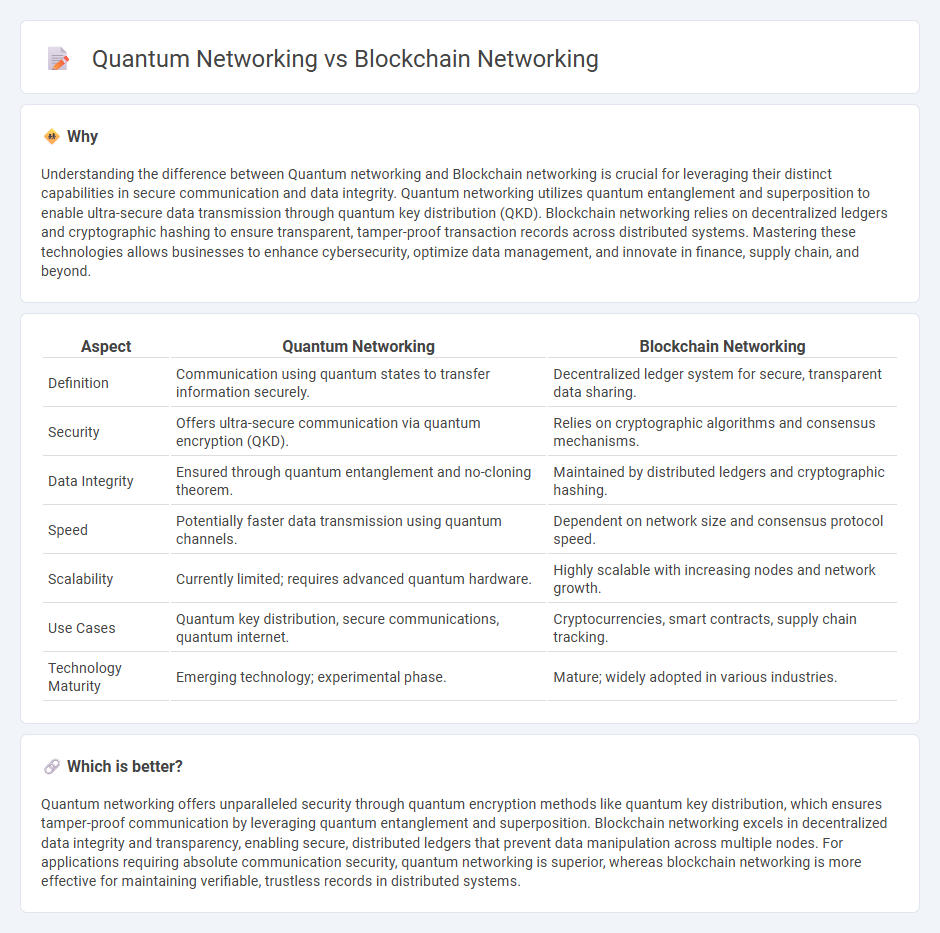
Quantum networking leverages qubits and quantum entanglement to enable ultra-secure, high-speed communication surpassing classical network capabilities. Blockchain networking relies on decentralized ledgers to achieve transparent, tamper-proof data exchange and consensus in distributed systems. Explore the distinctions and potential use cases of quantum and blockchain networking technologies to understand their impact on future digital infrastructures.
Why it is important
Understanding the difference between Quantum networking and Blockchain networking is crucial for leveraging their distinct capabilities in secure communication and data integrity. Quantum networking utilizes quantum entanglement and superposition to enable ultra-secure data transmission through quantum key distribution (QKD). Blockchain networking relies on decentralized ledgers and cryptographic hashing to ensure transparent, tamper-proof transaction records across distributed systems. Mastering these technologies allows businesses to enhance cybersecurity, optimize data management, and innovate in finance, supply chain, and beyond.
Comparison Table
| Aspect | Quantum Networking | Blockchain Networking |
|---|---|---|
| Definition | Communication using quantum states to transfer information securely. | Decentralized ledger system for secure, transparent data sharing. |
| Security | Offers ultra-secure communication via quantum encryption (QKD). | Relies on cryptographic algorithms and consensus mechanisms. |
| Data Integrity | Ensured through quantum entanglement and no-cloning theorem. | Maintained by distributed ledgers and cryptographic hashing. |
| Speed | Potentially faster data transmission using quantum channels. | Dependent on network size and consensus protocol speed. |
| Scalability | Currently limited; requires advanced quantum hardware. | Highly scalable with increasing nodes and network growth. |
| Use Cases | Quantum key distribution, secure communications, quantum internet. | Cryptocurrencies, smart contracts, supply chain tracking. |
| Technology Maturity | Emerging technology; experimental phase. | Mature; widely adopted in various industries. |
Which is better?
Quantum networking offers unparalleled security through quantum encryption methods like quantum key distribution, which ensures tamper-proof communication by leveraging quantum entanglement and superposition. Blockchain networking excels in decentralized data integrity and transparency, enabling secure, distributed ledgers that prevent data manipulation across multiple nodes. For applications requiring absolute communication security, quantum networking is superior, whereas blockchain networking is more effective for maintaining verifiable, trustless records in distributed systems.
Connection
Quantum networking leverages principles of quantum mechanics to enable ultra-secure communication through quantum key distribution, which enhances the security protocols used in blockchain networks. Blockchain networking benefits from quantum technologies by potentially improving consensus algorithms with quantum-resistant cryptography, addressing vulnerabilities posed by emerging quantum computers. The integration of quantum networking with blockchain creates a robust infrastructure for decentralized systems, ensuring enhanced data integrity and protection against cyberattacks.
Key Terms
Source and External Links
What is Blockchain Technology? - Blockchain networking involves different types of decentralized or distributed networks: public (permissionless), private (controlled by a single organization), hybrid (combining public and private access), and consortium (governed by multiple organizations with shared control and access policies).
Blockchain network - Hyperledger Fabric - Read the Docs - A blockchain network is a technical infrastructure connecting peers that host ledger copies and client applications via channels, facilitating decentralized ledger and smart contract services across organizations.
A beginner's guide to the different types of blockchain networks - Blockchain networks are distributed ledgers that enable organizations or users to record and trade assets securely and transparently, governed either publicly, privately, by consortiums, or permissioned frameworks, each offering different levels of access and control.
 dowidth.com
dowidth.com